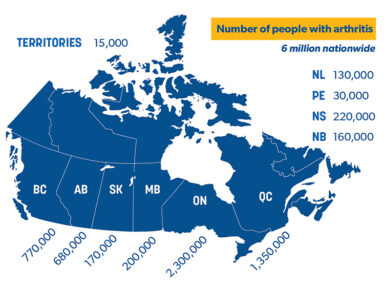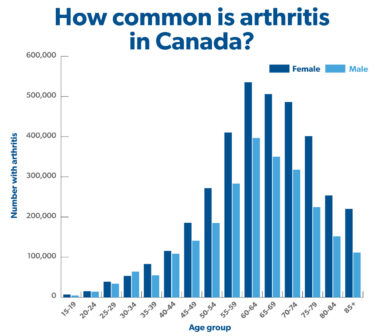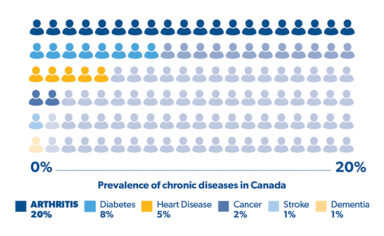Arthritis is a term used to describe a group of over 100 diseases characterized by inflammation in the joints or other areas of the body. Inflammation is a medical term that describes redness and swelling which causes pain and, when in the joints, can also cause stiffness. Left unchecked, inflammation can lead to significant and often irreparable damage to the affected areas, resulting in loss of function and disability.
Arthritis (arthro = joint, itis = inflammation) can involve almost any part of the body, most often affecting the hip, knee, spine or other weight-bearing joints, but also found in the fingers and other non-weight-bearing joints. Some forms of arthritis can also affect other parts of the body.
Arthritis is a chronic condition: it affects people on an ongoing, constant or recurring basis over months, years, even a lifetime.
General FAQs
Arthritis is a term used to describe a group of over 100 diseases characterized by inflammation in the joints or other areas of the body. Inflammation is a medical term that describes pain, stiffness, redness and swelling. Left unchecked, inflammation can lead to significant and often irreparable damage to the affected areas, resulting in loss of function and disability.
Arthritis is divided into two broad types (inflammatory arthritis and osteoarthritis) and is a chronic condition, affecting people on an ongoing, constant or recurring basis over months, years, even a lifetime.
For more information, visit About Arthritis.
Arthritis affects people of every age, gender and ethnic background. Genetics, age and lifestyle can all play a part in increasing one’s risk of developing arthritis. Today, 1 in 5 Canadians have arthritis. While it is largely an adult disease, it can also affect children. 1 in 2 adults age 65 and over have arthritis.
For more information on who is affected by particular types of arthritis, please see our individual disease descriptions.
Arthritis is very serious. It is actually Canada’s most prevalent chronic health condition. Left untreated, it can lead to significant and often irreparable damage to your joints, and in some cases your skin, organs and other areas of the body, resulting in pain, fatigue, loss of function and disability that can present considerable challenges to your quality of life. There is no cure for most forms, so once you have been diagnosed, arthritis is with you for life.
Your doctor will be able to provide a diagnosis based on your medical history, physical examination and diagnostic tests such as blood tests and x-rays. Early diagnosis is critical to successful treatment outcomes, so if you feel you may have arthritis symptoms, it is very important to speak to your doctor as soon as possible to obtain a diagnosis.
For more information, see our Signs of Arthritis.
There is no cure for arthritis – YET – but there is hope. When you are diagnosed early and start the right treatment plan, you can take control of your disease and help reduce or prevent damage to your joints and other tissues.
Meanwhile, the Arthritis Society’s funded scientists are working towards permanent solutions. To find out more about how your support is helping get us closer to a future without arthritis, visit our research page.
Left untreated, advanced forms of arthritis can eventually prove fatal and some forms such as diffuse scleroderma can prove fatal even with treatment. But even in moderate cases, most forms of arthritis can significantly erode your quality of life, especially if they are left undiagnosed or untreated for prolonged periods. Irreparable damage can occur in just a matter of weeks from first symptoms, which is why it’s so important to get diagnosed and put on a treatment plan as quickly as possible, especially for inflammatory forms of the disease.
For more information, see our Signs of Arthritis page.
Types of arthritis
Arthritis conditions are grouped into two broad categories:
Osteoarthritis (OA)
Osteoarthritis (OA) is the most common type of arthritis, affecting more Canadians than all other forms of arthritis combined. Though once referred to as the “wear-and-tear” arthritis, the Osteoarthritis Research Society International (OARSI) recently re-defined this condition. It describes OA as the result of the body’s failed attempt to repair damaged joint tissues*. While the joint damage can occur through deterioration associated with aging, it can also occur in response to an injury.
OA leads to the breakdown of cartilage (the tough elastic material that covers and protects the ends of bones), and the resulting bone-on-bone contact can cause pain, stiffness, swelling and reduced range of movement in the affected joint(s). The joints most commonly affected by OA are the knees, hips and those in the hands and spine.
There are many factors that are thought to contribute to developing OA, such as age, obesity, your sex, occupation, participation in certain sports, history of joint injury or surgery, and genetics. For more information, visit our osteoarthritis page.
Learn more about osteoarthritis
*Osteoarthritis Research Society International (OARSI)
FAQs: Osteoarthritis
- Very early symptoms of osteoarthritis are intermittent pain with strenuous activity; over time, the pain is present more often
- Morning stiffness or stiffness after a period of inactivity, usually lasting less than 30 minutes
- Joint grinding
Usually a few joints or a single joint, often with asymmetrical joint involvement early on (e.g. one knee may be affected but not the other)
- Weight-bearing joints, such as hips and knees
- Neck
- Lower back
- Hands
Inflammatory arthritis (IA)
Inflammatory forms of arthritis are different from osteoarthritis, in that the source of joint damage is from inflammation rather a wearing away of your cartilage. Most forms of IA are also autoimmune diseases, where the immune system – the body’s defense system against infections and other invaders – mistakenly starts to attack the body’s own healthy tissues.
Inflammation from these conditions can result in pain, stiffness, restricted mobility, fatigue and damage to joints and other tissues. If not identified and treated swiftly, these conditions tend to progress more quickly and aggressively than OA.
IA includes every form of arthritis except osteoarthritis – even some things you may not have realized were arthritis at all, like lupus or gout. Other common examples include rheumatoid arthritis, psoriatic arthritis and juvenile idiopathic arthritis, but there are many other types. Some forms of IA are considered systemic diseases, because they can affect the whole body. For more information, visit our inflammatory arthritis page.
FAQs: Inflammatory Arthritis
There are many forms of inflammatory arthritis; signs that are typical for most include:
- Pain, swelling and stiffness in one or multiple joints
- Morning stiffness in and around the affected joints lasting at least one hour
- Pain and stiffness that worsens with inactivity and improves with physical activity
- Reduced range of motion
- Sometimes fever, weight loss, fatigue and/or anemia
- Usually affects multiple joints
- Different types of inflammatory arthritis have differing patterns of joint involvement. For example rheumatoid arthritis tends to be symmetrical, involving joints on both sides of the body (e.g. both hands, both elbows, etc.) whereas psoriatic arthritis maybe symmetrical or asymmetrical
Any joint can be affected, but most commonly:
- Small joints of the hands and feet
- Wrists, elbows, shoulders, knees, lower back and hips
Living with arthritis?
Arthritis symptoms can range from mild to severe. Most people with arthritis experience chronic pain, fatigue, restricted mobility, lowered mood and other symptoms that can combine to erode their quality of life.
Many forms of arthritis can lead to episodic disability, leaving people unable to work for periods of time due to their disease.
For millions of Canadians, arthritis can threaten their ability to enjoy freedom of movement, productive work, restful sleep, and an existence free of unnecessary pain.
Arthritis Facts and Figures
Arthritis is a serious disease that can have devastating impacts on people’s lives.
As the most common chronic disease in Canada, it places a tremendous burden on the healthcare system and Canadian society at large, as well as the 6 million people in Canada who must live with its effects, and their caregivers, families and friends. Arthritis affects people of all ages across the country, interfering with both physical and mental health, and diminishing quality of life.

Source: ACREU 2023, based on CCHS 2019-2021 (provinces) and CCHS 2017-2021 (territories)
Arthritis is more common than many people think.
About 6 million people in Canada (1 in 5 adults) have arthritis, and its impacts extend even to their family members, caregivers and friends.
In Canada, arthritis is more common in people assigned female at birth (1 in 4) than people assigned male at birth (1 in 6). It can strike people of any sex, gender, and age. While it becomes more common at older ages, half of the people in Canada with arthritis are younger than 65.

Arthritis is the most common chronic disease in Canada.
When asked about long-term, chronic diseases, more people in Canada report living with arthritis than diabetes, heart disease, cancer, stroke, and dementia combined.

Source: ACREU 2023, based on CCHS 2019-2021 (prevalence of arthritis by age) and CCHS 2021 (prevalence of arthritis in comparison to other chronic diseases)
By 2045, the number of people in Canada living with arthritis is expected to grow by 50%.
Arthritis is a serious problem in Canada, and this challenge is constantly growing. As baby boomers age and life expectancies increase, we expect arthritis to be on the rise – with major impacts on individuals, families, and the healthcare system.
If we don’t take action today, by 2045 the number of people with arthritis in Canada will reach a staggering 9 million.
Source: ACREU 2023, based on CCHS 2019-2021 and Statistics Canada Projected Population 2022
People with arthritis report worse general health.
People in Canada with arthritis are nearly 3 times as likely to say that their general health isn’t good, compared to those without arthritis.
For many people, it’s not as simple as “just arthritis”. If you have arthritis, you’re more likely to live with other health problems, regardless of your age. That can mean dealing with the symptoms of multiple chronic diseases at once, along with different treatments and side effects.
About 4 out of 5 people in Canada with arthritis have at least one other chronic health condition such as back problems, high blood pressure, high cholesterol, heart disease, diabetes, mood disorders, or anxiety disorders.
Source: ACREU 2023, based on CCHS 2021
People with arthritis report worse mental health.
While arthritis compromises physical health, its impact does not stop there. People in Canada with arthritis are up to twice as likely to say that their mental health isn’t good across age groups spanning from 25 to 84 years old, compared to those without arthritis.
If you have arthritis, you’re more likely to live with mood or anxiety disorders. Depending on the age group examined, people in Canada with arthritis are up to 2 to 3 times as likely to have a mood disorder like depression compared to those without arthritis. They’re also up to 2.5 times as likely to have an anxiety disorder.
Source: ACREU 2023, based on CCHS 2021
People with arthritis live with pain, and for many, it disrupts their daily lives.
Pain is something that we can all relate to. We try our best to avoid it, and to protect those we love from it. But for people living with arthritis, pain is all too often a part of daily life.
For more than 40% of people in Canada with arthritis, pain is severe enough to limit their activities. This means that significant pain and discomfort disrupts the lives of about 2.5 million people living with arthritis in Canada.
People in Canada with arthritis are 4 times as likely to live with pain that interferes with their activities, compared to people who don’t live with this devastating chronic disease.
Source: ACREU 2023, based on CCHS 2019-2020
People with arthritis often struggle with disability in daily life – especially difficulties with mobility.
The ability to move around, get dressed, and go about our daily lives without debilitating pain or stiffness is often taken for granted. But this is not a given for many people with arthritis.
Compared to people in Canada without arthritis, those living with this disease are more than 5 times as likely to have difficulties with mobility – their ability to walk, climb steps, and take care of themselves through activities like washing and dressing. This burden is even greater in those younger than 45 years of age.
Source: ACREU 2023, based on CCHS 2017
Millions of people in Canada have to deal with living and working with arthritis.
Arthritis is a leading cause of disability and work limitations in Canada.
Working-aged people in Canada with arthritis are twice as likely to report that they are not participating in the workforce compared to their peers without arthritis. Significantly reduced participation is seen across all stages of adulthood and highlights an increased need for support for starting and staying in work, especially at younger ages.
Source: ACREU 2023, based on CCHS 2019-2020 data for working-aged respondents
For many years, Arthritis Society Canada has partnered with the interdisciplinary research team at the Arthritis Community Research and Epidemiology Unit (ACREU) to evaluate the prevalence and impact of arthritis in Canada. By learning more about the burden of arthritis on individuals and the healthcare system, this partnership has helped showcase how to improve support for people living with this disease.
Since its founding in 1991, ACREU has been committed to shedding light on the impact of arthritis on people, their families, the overall population, and how arthritis care is delivered.
The Status of Arthritis in Canada report is typically reviewed and updated every two years by ACREU for Arthritis Society Canada. The current report (October 2023) is based on an analysis of Statistics Canada’s Canadian Community Health Survey (CCHS) cycles 2015-2021 using the most recently available data. These surveys collect self-reported health information from a representative sample of the Canadian population. Unless otherwise noted, data analysed do not cover the territories, children under 12 years old, people living on reserves, and members of the Canadian Armed Forces.
Contact [email protected] for the full report upon request.
Special Topic: The burden of osteoarthritis across all ages
Osteoarthritis is the most common form of arthritis.
More than 4 million Canadians have osteoarthritis (OA), more than all other types of arthritis combined. About 1 in 7 Canadian adults live with the impact of this progressive, painful disease.
It most certainly is not an “old person’s disease”.
Nearly one third of people with OA report being diagnosed before the age of 45. Expecting to be at the peak of their social and professional lives, these younger adults feel unexpectedly sidelined.
The debilitating impact of OA on younger adults can be similar, or even worse, than on seniors.
Younger adults under 45 with OA report that the disease has a substantial impact on their lives. Nearly one third of younger adults with OA live with severe and frequent joint pain — the same proportion as in older adults with OA over 75. Younger adults with OA also have more trouble with poor sleep and fatigue than older adults with OA, with the greatest impact seen in young women.
OA disrupts the ability to work.
Nearly half (42%) of the working-age population with OA (i.e., 20-64 years old) reports not being in the labour force or in school, compared to less than one fifth (19%) of the general population.
Younger adults with OA live with mental health impacts.
Beyond the physical impact of OA, younger adults with the disease are more than twice as likely to say their mental health isn’t good, compared to their peers in the general population. More than 30 per cent report being diagnosed with a mood or anxiety disorder as well as OA. Perceiving life as stressful, dissatisfaction with life is more pronounced among younger adults with OA than their peers, or compared to older adults with OA.
These findings shine a light on the unrecognized burden of OA at all ages, including young adulthood. These insights and others were derived from a special report entitled The Burden of Osteoarthritis in Canada (2021) by the Arthritis Community Research and Evaluation Unit (ACREU) commissioned by Arthritis Society Canada. Read a summary of the report for more information [PDF 124kB]. Contact [email protected] for the full report upon request.
Learn more about osteoarthritis and support for young adults with arthritis.
Data source: Except where specified otherwise, these facts and figures are drawn from the Status of Arthritis in Canada report (October 2023) developed by the Arthritis Community Research and Epidemiology Unit (ACREU) for Arthritis Society Canada based on an analysis of Statistics Canada’s Canadian Community Health Survey (CCHS) cycles 2015 to 2021 as noted in footnotes. These surveys collected self-reported health information from a representative sample of the Canadian population. Unless otherwise noted, data analysed did not cover the territories, children under 12 years old, people living on reserves, and members of the Canadian Armed Forces.

